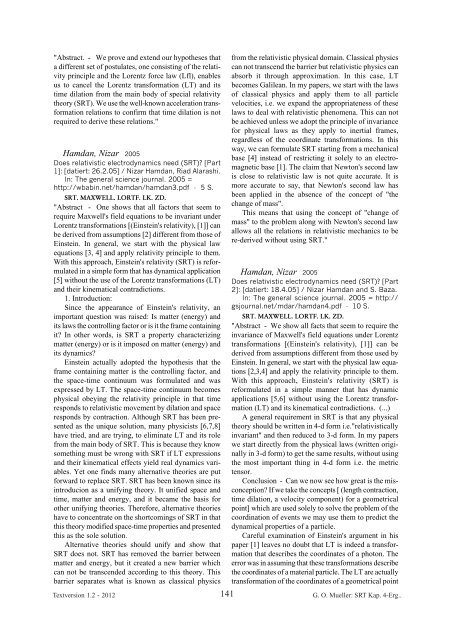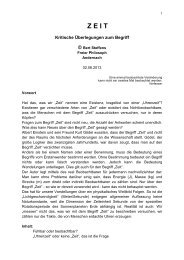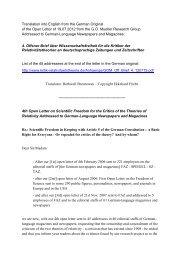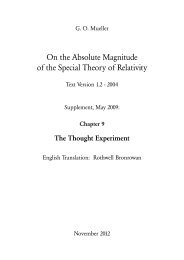2394 weitere kritische Veröffentlichungen - Kritische Stimmen zur ...
2394 weitere kritische Veröffentlichungen - Kritische Stimmen zur ...
2394 weitere kritische Veröffentlichungen - Kritische Stimmen zur ...
Sie wollen auch ein ePaper? Erhöhen Sie die Reichweite Ihrer Titel.
YUMPU macht aus Druck-PDFs automatisch weboptimierte ePaper, die Google liebt.
"Abstract. - We prove and extend our hypotheses that<br />
a different set of postulates, one consisting of the relativity<br />
principle and the Lorentz force law (Lfl), enables<br />
us to cancel the Lorentz transformation (LT) and its<br />
time dilation from the main body of special relativity<br />
theory (SRT). We use the well-known acceleration transformation<br />
relations to confirm that time dilation is not<br />
required to derive these relations."<br />
Hamdan, Nizar 2005<br />
Does relativistic electrodynamics need (SRT)? [Part<br />
1]: [datiert: 26.2.05] / Nizar Hamdan, Riad Alarashi.<br />
In: The general science journal. 2005 =<br />
http://wbabin.net/hamdan/hamdan3.pdf - 5 S.<br />
SRT. MAXWELL. LORTF. LK. ZD.<br />
"Abstract - One shows that all factors that seem to<br />
require Maxwell's field equations to be invariant under<br />
Lorentz transformations [(Einstein's relativity), [1]] can<br />
be derived from assumptions [2] different from those of<br />
Einstein. In general, we start with the physical law<br />
equations [3, 4] and apply relativity principle to them.<br />
With this approach, Einstein's relativity (SRT) is reformulated<br />
in a simple form that has dynamical application<br />
[5] without the use of the Lorentz transformations (LT)<br />
and their kinematical contradictions.<br />
1. Introduction:<br />
Since the appearance of Einstein's relativity, an<br />
important question was raised: Is matter (energy) and<br />
its laws the controlling factor or is it the frame containing<br />
it? In other words, is SRT a property characterizing<br />
matter (energy) or is it imposed on matter (energy) and<br />
its dynamics?<br />
Einstein actually adopted the hypothesis that the<br />
frame containing matter is the controlling factor, and<br />
the space-time continuum was formulated and was<br />
expressed by LT. The space-time continuum becomes<br />
physical obeying the relativity principle in that time<br />
responds to relativistic movement by dilation and space<br />
responds by contraction. Although SRT has been presented<br />
as the unique solution, many physicists [6,7,8]<br />
have tried, and are trying, to eliminate LT and its role<br />
from the main body of SRT. This is because they know<br />
something must be wrong with SRT if LT expressions<br />
and their kinematical effects yield real dynamics variables.<br />
Yet one finds many alternative theories are put<br />
forward to replace SRT. SRT has been known since its<br />
introducion as a unifying theory. It unified space and<br />
time, matter and energy, and it became the basis for<br />
other unifying theories. Therefore, alternative theories<br />
have to concentrate on the shortcomings of SRT in that<br />
this theory modified space-time properties and presented<br />
this as the sole solution.<br />
Alternative theories should unify and show that<br />
SRT does not. SRT has removed the barrier between<br />
matter and energy, but it created a new barrier which<br />
can not be transcended according to this theory. This<br />
barrier separates what is known as classical physics<br />
from the relativistic physical domain. Classical physics<br />
can not transcend the barrier but relativistic physics can<br />
absorb it through approximation. In this case, LT<br />
becomes Galilean. In my papers, we start with the laws<br />
of classical physics and apply them to all particle<br />
velocities, i.e. we expand the appropriateness of these<br />
laws to deal with relativistic phenomena. This can not<br />
be achieved unless we adopt the principle of invariance<br />
for physical laws as they apply to inertial frames,<br />
regardless of the coordinate transformations. In this<br />
way, we can formulate SRT starting from a mechanical<br />
base [4] instead of restricting it solely to an electromagnetic<br />
base [1]. The claim that Newton's second law<br />
is close to relativistic law is not quite accurate. It is<br />
more accurate to say, that Newton's second law has<br />
been applied in the absence of the concept of "the<br />
change of mass".<br />
This means that using the concept of "change of<br />
mass" to the problem along with Newton's second law<br />
allows all the relations in relativistic mechanics to be<br />
re-derived without using SRT."<br />
Hamdan, Nizar 2005<br />
Does relativistic electrodynamics need (SRT)? [Part<br />
2]: [datiert: 18.4.05] / Nizar Hamdan and S. Baza.<br />
In: The general science journal. 2005 = http://<br />
gsjournal.net/mdar/hamdan4.pdf - 10 S.<br />
SRT. MAXWELL. LORTF. LK. ZD.<br />
"Abstract - We show all facts that seem to require the<br />
invariance of Maxwell's field equations under Lorentz<br />
transformations [(Einstein's relativity), [1]] can be<br />
derived from assumptions different from those used by<br />
Einstein. In general, we start with the physical law equations<br />
[2,3,4] and apply the relativity principle to them.<br />
With this approach, Einstein's relativity (SRT) is<br />
reformulated in a simple manner that has dynamic<br />
applications [5,6] without using the Lorentz transformation<br />
(LT) and its kinematical contradictions. (...)<br />
A general requirement in SRT is that any physical<br />
theory should be written in 4-d form i.e."relativistically<br />
invariant" and then reduced to 3-d form. In my papers<br />
we start directly from the physical laws (written originally<br />
in 3-d form) to get the same results, without using<br />
the most important thing in 4-d form i.e. the metric<br />
tensor.<br />
Conclusion - Can we now see how great is the misconception?<br />
If we take the concepts [ (length contraction,<br />
time dilation, a velocity component) for a geometrical<br />
point] which are used solely to solve the problem of the<br />
coordination of events we may use them to predict the<br />
dynamical properties of a particle.<br />
Careful examination of Einstein's argument in his<br />
paper [1] leaves no doubt that LT is indeed a transformation<br />
that describes the coordinates of a photon. The<br />
error was in assuming that these transformations describe<br />
the coordinates of a material particle. The LT are actually<br />
transformation of the coordinates of a geometrical point<br />
Textversion 1.2 - 2012 141<br />
G. O. Mueller: SRT Kap. 4-Erg..





